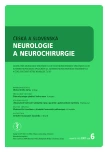Swallowing Disorders Related to Vertebrogenic Dysfunctions
Authors:
E. Vaňásková 1; A. Hep 2; J. Vižďa 3; V. Tošnerová 1
Authors‘ workplace:
Rehabilitační klinika LF UK a FN Hradec Králové
1; Interní gastroenterologická klinika LF MU a FN Brno-Bohunice
2; Oddělení nukleární medicíny FN Hradec Králové
3
Published in:
Cesk Slov Neurol N 2007; 70/103(6): 692-696
Category:
Short Communication
Overview
Objective:
Functional disorders of the gastrointestinal tract are a frequent cause of problems reported by patients to practicing specialists in a number of fields. Our study was focused on swallowing disorders (dysphagias) in the region of the esophagus related to disorders of the motor system in the region of cervical and thoracic spine.
Patient group and methods:
The monitored group consisted of 48 patients, of which 6 men and 42 women (ranging from 22 to 71 years of age). The patients were included in the group for pain in the region of the cervical or thoracic spine and concomitant difficulty swallowing of non-obstructive nature described as the feeling of stuck food or liquid. We used dynamic scintigraphy of the esophagus to examine the swallowing act in order to evaluate the mean transit time (MTT) of the passage of liquid through the esophagus. The patients were treated with rehabilitation for a period of 2–3 weeks.
Results:
Radio-isotope measurement of esophageal motility showed a statistically significant reduction in MTT from the mean value of 10.3 seconds to 7.6 seconds (p = 0.000129). Significant improvement in the following parameters was recorded for the patients with a decrease in the MTT value: degree of dysphagia, intensity of pain in the C and Th regions of the spine, reduction in pathological findings in the region of the lower cervical spine, of the C/Th transition, the first rib and the proximal thoracic spine, reduced finding of the trigger points in the region of the m. sternocleidomastoideus and mm. scaleni.
Conclusions:
We found important links between non-obstructive dysphagias, the length of MTT and the motor system disorders. Rehabilitation had a positive effect on pain, reduced the incidence of clinical findings and resulted in the suppression of difficulty swallowing symptoms. Dynamic scintigraphy of the esophagus allowed for objective evaluation of the therapeutic effect.
Key words:
dysphagia – esophagus motility disorder – functional disorders – vertebrovisceral relations
Sources
1. Šetka J, Mařatka Z. Jícen a kardie. In: Mařatka Z (Ed). Klinická gastroenterologie. 1. ed. Praha: Avicenum 1988 : 148-158.
2. Hep A, Válek V, Dolina J, Prášek J, Dítě P. Klinický význam polykacích potíží. Medica Revue 1997; 4 : 30-31.
3. Vaira D, Gatta L, Ricci C, D’Anna L, Miglioli M. How valuable is the application on konsensus guidelines in the management of functional gastrointestinal disorders? Dig Dis 2001; 19 : 225-231.
4. Bednařík J, Hep A. Poruchy motility jícnu při neurologických poruchách. In: Horký K (Ed). Lékařské Repetitorium. 1. ed. Praha: Galén 2003 : 495.
5. Valadka AB, Kubal WS, Smith MM. Updated management strategy for patients with cervical osteophytic dysphagia. Dysphagia 1995; 10 : 167-171.
6. Ozgocmen S, Kiris A, Kocakoc E, Ardicoglu O. Osteophyte – induced dysphagia: report of three cases. Joint Bone Spine 2002; 69 : 226-229.
7. Forejtová Š, Klézl Z, Barterová J, Peterová V, Štolfa J, Pavelka K. Dysfagie horního typu u pacienta s difuzní idiopatickou skeletální hyperostózou. Čes Revmatol 2004; 12 : 125-128.
8. Maurer AH, Fisher RS. Current applicability of scintigraphic methods in gastroenterology. Baillieres Clin Gastroenterol 1995; 9 : 71-95.
9. Mughal MM, Marples M, Bancewicz,J. Scintigraphic assessment of oesophageal motility: what does it show and how reliable is it? Gut 1986; 27 : 946-953.
10. Netscher D, Larson GM, Polk HC jr. Radionuclide esophageal transit. Arch Surg 1986; 121 : 843-848.
11. Hep A, Vaňásková E, Tošnerová V, Prášek J, Vižďa J, Dítě P et al. Radionuclide oesophageal transit scintigraphy - a useful method for verification of oesophageal dysmotility by cervical vertebropathy. Dis Esophagus 1999; 12 : 47-50.
12. Vaňásková E, Hep A, Lewit K, Tošnerová V, Prášek J, Vižďa J et al. Cervical dysfunction with disturbed oesophageal motility - scintigraphic assessment. J Orthop Med 2001; 23 : 9-11.
13. Lewit K. Etiologie a patogeneze. In: Lewit K (Ed). Manipulační léčba v myoskeletální medicíně. 5. ed. Praha: Sdělovací technika a Česká lékařská společnost JEP 2003 : 25-52.
14. Beal M., Dvorak J. Palpatory examination of the spine: a comparison of the results of two methods and their relationship to visceral disease. Manual Med 1984; 1 : 25-32.
15. Jandová J. Vertebroviscerální vztahy. Doporučené postupy pro praktické lékaře. Projekt MZ ČR zpracovaný ČLS JEP za podpory grantu IGA MZ ČR 5390-3. Reg. č. a/079/113.2001, 8 s. Dostupné na http://www.cls.cz/dp/2001/r113.rtf.
16. Hülse M. Zervikale Dysfonie. Folia Phoniatr (Basel) 1991; 43 : 181-196.
17. Rychlíková E. Vertebrokardiální syndrom: diferenční diagnostika a terapie. 1. ed. Praha: Avicenum 1975.
18. Janda V. Cervikocervikální přechod. Rehabil Fyz Lék 2002; 9 : 3‑4.
19. Pickering M, Jones JFX. The diaphragm: two physiological muscles in one. J Anat 2002; 201 : 305-312.
20. Clouse RE, Lustman PJ. Psychiatric illness and contraction abnormalities of the oesophagus. N Engl J Med 1983; 309 : 1337-1342.
21. Boyd C, Abraham S, Kellow J. Psychological features are important predictors of functional gastrointestinal disorders in patiens with eating disorders. Scand J Gastroenterol 2005; 40 : 929-935.
22. Snape WJ jr. Role of motility measurements in managing upper gastrointestinal dysfunction. Gastroenterologist 1998; 6 : 44-59.
23. Mariani G, Boni G, Barreca M, Bellini M, Fattori B, AlSharif A et al. Radionuclide gastroesophageal motor studies. J Nucl Med 2004; 45 : 1004-1028.
24. Thrall JH. Gastrointestinal system. In: Thrall JH, Ziessman HA (Eds). Nuclear Medicine: the requisites. 2nd ed. St. Louis: Mosby 2001 : 266-273.
Labels
Paediatric neurology Neurosurgery NeurologyArticle was published in
Czech and Slovak Neurology and Neurosurgery

2007 Issue 6
Most read in this issue
- Facial Palsy
- Swallowing Disorders Related to Vertebrogenic Dysfunctions
- Antibodies Against Glycoconjugates in the Diagnosis of Autoimmune Neuropathies
- Dercum’s Disease (Lipomatosis Dolorosa) – a Rarely Diagnosed Disease: a Case Study
